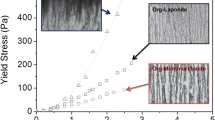Abstract
Three ball clays (SP from England, TSMA from France and UK from the Ukraine) were characterized for their dry and wet colloidal properties. On the basis of X-ray diffraction and chemical analyses the clays were classified as kaolinite-rich clay, smectitic kaolinite-rich clay and illitic kaolinite-rich clay. The ζ (zeta) potential at the clay-water interface as a function of pH, in three different electrolytes, was investigated using an electroacoustic technique. Starting from measurements of dynamic mobility, the calculated ζ potential was found to be almost constant as a function of pH for the TSMA and UK clays, while it increased from −20 to −60 for the SP clay, when potassium nitrate was used as an electrolyte. The behavior of the three clays in calcium and magnesium nitrate was slightly different: SP showed a smaller increase in ζ potential, while a small deviation from the constant behavior of the UK clay was found. The results are explained in terms of the surrounding-ion atmosphere in light of the chemical-physical properties measured. Our results may well be of use to those involved in ceramic processing.
Similar content being viewed by others
References
Barrow, N.J. (1987) Reactions with Variable Charge Sols. M. Nijhoff, Dordrecht, The Netherlands.
Dixon, J.B., Weed, S.B. and Rich, C.I., editors (1977) Minerals in Soil Environments. Soil Science Society of America, Madison, Wisconsin, 948 pp.
Fabbri, B., Fiori, C., Krajewski, A., Valmori, R. and Tenaglia, A. (1986) Comparison between traditional mineralogical and computerized rational analysis of ceramic raw materials. Journal de Physique, 47, 57–62.
Greenland, D.J. and Hayes, M.H.B., editors (1978) The Chemistry of Soil Constituents. Wiley, New York, 508 pp.
Grim, R. E. (1968) Clay Mineralogy, 2sund edition. McGraw Hill, New York.
Grimshaw, R.W. (1971) The Chemistry and Physics of Clays, 4th edition. Wiley Interscience, New York, 256 pp.
Hang, P.T. and Brindley, G.W. (1970) Methylene blue adsorption by clay minerals. Determination of surface areas and cation exchange capacities (clay-organic study XVIII). Clays and Clay Minerais, 18, 203–212.
Jeffery, E. G. and Hutchison, D. (1981) Chemical Methods of Rock Analysis. Pergamon Press, Oxford, UK.
Loewemberg, M. and O’Brien, R.W. (1992) The dynamic mobility of nonspherical particles. Journal of Colloid and Interface Science, 150, 158–168.
Lyklema, J. (1987) Structure of the solid/liquid interface and the electrical double layer. Pp. 63–90 in: Solid/Liquid Dispersions (Th. F. Tadros, editor). Academic Press, London, 331 pp.
Lyklema, J. (1995) Fundamentals of Interface and Colloid Science Volume II: Solid-Liquid Interfaces. Academic Press, London.
O’Brien, R.W. and Rowlands, W.N. (1995) Electroacoustic determination of particle size and zeta potential. Journal of Colloid and Interface Science, 173, 406–418.
Pugh, R.J. and Bergström, L., editors (1994) Surface and Colloid Chemistry in Advanced Ceramics Processing. Surfactant Science Series, Vol. 51, Marcel Dekker, New York, 363 pp.
Rasmusson, M., Rowlands, W.N., O’Brien, R.W. and Hunter, R.J. (1997) The dynamic mobility and dielectric response of sodium bentonite. Journal of Colloid and Interface Science, 189, 92–100.
Rowlands, W.N. and O’Brien, R.W. (1995) The dynamic mobility and dielectric response of kaolinite particles. Journal of Colloid and Interface Science, 175, 190–200.
Schroth, B.K. and Sposito, G. (1997) Surface charge properties of kaolinite. Clays and Clay Minerals, 45, 85–91.
Sondi, I. and Pravdič, V. (1996) Electrokinetics of natural and mechanically modified ripidolite and beidellite clays. Journal of Colloid and Interface Science, 181, 463–469.
Sondi, I., Biščan, J. and Pravdič, V. (1996) Electrokinetics of pure clay minerals revisited. Journal of Colloid and Interface Science, 178, 514–522.
Sondi, I., Milat, O. and Pravdič, V. (1997) Electrokinetic potential of clay surfaces modified by polymers. Journal of Colloid and Interface Science, 189, 66–73.
Tari, G., Bobos, J., Gomes, C.S.F. and Ferreira, J.M.E. (1999) Modification of surface charge properties during kaolinite to halloysite-7A transformation. Journal of Colloid and Interface Science, 210, 360–366.
Van Olphen, H. (1977) An Introduction to Clay Colloid Chemistry for Clay Technologists, Geologists and Soil Scientists, 2nd edition. Wiley, New York, 318 pp.
Worral, W.E. (1975) Clays and Ceramic Raw Materials. Applied Science Publishers, Glasgow, 203 pp.
Author information
Authors and Affiliations
Corresponding author
Rights and permissions
About this article
Cite this article
Galassi, C., Costa, A.L. & Pozzi, P. Influence of Ionic Environment and pH on the Electrokinetic Properties of Ball Clays. Clays Clay Miner. 49, 263–269 (2001). https://doi.org/10.1346/CCMN.2001.0490309
Received:
Revised:
Published:
Issue Date:
DOI: https://doi.org/10.1346/CCMN.2001.0490309




